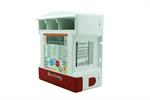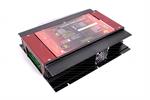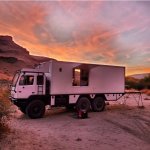24 volt military diesel generator for charging them. I looked into FeLiPO4 (Lithium Iron phosphate) and so called "Lead crystal" aka Lead-calcium-gallium plate batteries with SiO2 based electrolyte. I don't like the limited temperature range of the Lithium iron phosphate batteries. The only downside of the "lead crystal" battery seems to be lack of suitable charger options. Does anybody in this forum have experience building battery banks?...
Similar boat as yourself.. but little further along..... actually committed pretty much now to a system since have most parts. Here is some food for thought in all your batt and charging quest for info.
Before reading below.... if your familiar with Lithium batts you likely know what a BMS is. Below info is NOT a typo...
BBMS is NOT same thing as a BMS so do not confuse yourself as you read on.
REDD's charging system
. diesel Aux Power Unit to be generator plus some ... will swap it to 100amp 24v alt. to charge Aux/House batts. Will start on its own batt or truck engine start bat?? Will have step down to 12v for its own components (has engine preheat, cab heat and cab AC built in)
. 1000w solar.... Each 100w panel to be paired with another for 24v output. May put more panels on the tow behind Jeep as well.
. multiple weatherproof (IP68.) 24v MPPT solar chargers. (one per panel pair) Multiple is for redundancy mostly. If one panel gets damaged ... full output from others still maximized. MPPT sorta does this anyway... but even more so with multiple controllers. Also it might give me smidge better charge in clouds/shadows
. 110v PowerMax 50amp 3 stage smart lithium or lead (will be on lead) RV converter/charger.
. alternator (200amp neihoff dual volt) if it last.. came off a hummer
. NATO will stay intact allowing to charge EVERYTHING lead and lithium off another 24v Military truck or generator.
.
BBMS (Battery BANK Management System)... invented for live on sail boats that already have good large lead House Banks... and owners wanted to add lithium to the mess most efficient way as possible.
. 24v Battery charge isolator.. Common item in RV's etc. When "start bank" is full by alternator it flicks alt charging to another bank .... in my case will be (#1) Aux/House bank. This particular one though is more like DC-lead/DC-lead charger with a switch to not allow charging to house bank till start bank is full. Also has a button you can use to jump start batts from house batts. More common type literally switches alternator output between start/house banks.
. 100amp Battery equalizers for each lead bank
. pulse de-sulfators on each lead bank.
Battery system Plan. NOT TYPICAL- can not, recommend this setup NOR not recommend against it either.. just what I will be trying. 3 banks of batts, each own reason and purpose . Two are House banks and work as team though.
.
House Reservoir bank 400 ah at 24VOLTS (two 200ah 24v LiPo4 rack batteries (alibaba) ( #2 in details)
.
Aux/House bank (#1 in details
). four 12v common walmart like lead acid batts- 200ah total? Maybe AGM.
.
Start bank (two 12v generic walmart lead acid batts? arragned in FMTV 12v/24v OEM-ish arragement to operate truck.
More-detail on banks
(#1)- Aux/House bank w/Lead chemistry 24v. This is main use bank. Numerous reasons why
A.- Winching, welding, etc. are harsh on battery. Lead more robust.
B.- These tools are not yet commonly designed for how fast lithium can pump energy into them so it is hard on them too. TOOLS is the "Aux(ilary)." reasoning in this bank's makeup and name.
C.- charging 24v lead is what I have on hand already..... especially the costly Neihoff 200amp or upgrade to civy alt.
D.- what need to buy still is less costly way went about it... BBMS less costly and opens higher amp charging abilities than most Dc/Dc per dollar . 24v lithium charging $tuff is ouch expen$ive per potential amp charge.
E. short term cost lower.
(#2)- Lithium Reservoir Bank 24v. This will be like a HUGE reservoir behind a damn. Like water release from damn; electricit released from lithium will be managed by BBMS when solar, APU, etc etc is outputting to little/not at all- BBMS will flow energy from #2 Lithium "Reservoir" into the #1 Lead Aux/House bank in attempt to keep it topped off at all times.
------Lithium bank will be mounted in a heated area of camper .... and may have additional heat when needed for charging thru Solar (managed by BBMS). Thus in winter/ but camper not in being heated mode.. may put heater on them. Maybe?? lots of van lifers find interior mounting is sufficient and not need to heat batts. ESP. if chargers etc. are set do not allow charging below certain temps..... which 99.9% of all solar chargers do via battery temp sensor or via mounting the solar charge controller in same area as battery to keep its temp sensor dongle near batts.
What is
BBMS- It is a charging manager between a WHOLE lead bank and a WHOLE lithium bank that manages electrical flow between them.
BBMS does charge managing in BOTH directions very smartly between both battery banks (each of different chemistry- one bank lead. one bank lithium) It manages the flow within the charge parameters for each chemistry. BBMS caries out its management programing via amperage sensor which gives it smarter management ability than Dc/Dc chargers (and many others) which go by voltage settings. BTW a battery with a BMS is for a that single battery only, and typically is housed inside each single battery. It sole purpose is PROTECTION not usage/charge managing.
Thus in general REDD's charge set up it will go like this: EQUILIZER(s) balances Lead Banks and a pulse desulfator comes into play as well.
: additional isolated small 24v solar panel charges Lead Start Bank directly when sitting
: alternator charges Lead Start Bank when CAT is running
: ---Battery isolator opens when Start Bank is charged and begins charging Lead Aux/house bank instead
OR / Anything else that might be charging Aux./House bank like APU, grid tie or solar.... which is also hooked to Aux/House bank too
:--- energy flows from Aux/House batts immediately to lithium thru the BBMS till it is full.
:--- when Lithium full..... final full charge done to Lead Aux/House gets completed.
NOTE- as I understand it..... By design of typical charge regulators/controllers combined with mother nature's flow of electrons- any bank with multiple chargers will accept (in general) charging only from what is pumping most significant electrons into them. Charger gizmo with less charging output will sense the more powerful incoming charge from other gizmo and back off..... Example.... Alternator charging at available 140amp or so will force solar charging at 60amp, when both on same bank, to dial back to mostly not be charging.
In Detail- How CHARGING works with BBMS managing lithium Reservoir BANK & partnering Lead Acid Aux/House BANK .
:------incoming charge (solar, APU, alternator, grid etc.) will flow thru Aux/house Lead batts to Lithium Reservoir. Mostly due to path of least resistance. It moves right on thru lead batt bank to the BBMS which manages that flow into the lithium batt bank. Maybe slows a little as it goes thru lead?? with lead chemisty slowing it down some??
:-------- Multi stage charging managed by BBMS into Lithium when energy flows from lead to it. It does same in other direction of Lithium to lead.
: ---------------When Lithium BANK is Full BBMS.. disallows* any more charge in. Should be fairly quick with alternator/grid.. matters how discharged it got.
:--------------- Once lithium full; any/all charging gizmos in action then charge ONLY the Aux/House Lead batt Bank till it is full too......during this phase charge parameters for the lead is controlled by gizmos be it Alternator regulator , solar charge controller, Grid charger etc. Again this should be quick with alternator/grid.
How POWER DRAW works when BBMS is managing lithium Reservoir Bank, AND Lead Aux/House Bank . Does not matter if power draw is for House use or Aux. use... all power is drawn from the Lead Aux/House Bank. (except start and vehicle operation power which has it's own bank)
A power draw happens- comes out of Aux/House
. When charging is happening at same time (Alt, solar, APU, grid....) and charge output matches/exceeds draw ... its a match... Lithium reservoir stays at it's level or goes up in charge if charge in, exceeds draw out.
If draw out exceeds charge in like say at low light hours, engine off, APU off so not to bother Mother Nature or other Campers when at boondock camp site??? Yet the refrigerator, cooking pot, Air Con, and tools etc. all in use- BBMS will send charge from the lithium Reservoir Bank into the lead Aux/House Bank (multi stage charging happening based on Lead charge parameters programed in the BBMS) will replace any electrical storage drawn out, (up to a point) Hence why I term this lithium bank as a "Reservoir". So in essence when no /not enough charging is going on- the BBMS opens managed flood gates so Lithium reservoir can flow into the Aux/House's Lead Acid bank to keep it full all the time (up to a point .. BBMS wont allow over discharge of lithium).
So again- benefits of two different chemistry making up the house bank system- Any hard stuff on batts like winching with 24v winches, 24v tools, Welder ... etc. is ONLY beating up on robust less expensive to replace, lead batteries. The Lithium keeping the lead Aux/House bank most always at full charge; makes lead last longer than typical. Lithium is happy to be discharged more often... so all good there too. Team work.
So that is REDD's plan. Maybe some of this drivel helps you make decisions.
*either DC/DC charger or BBMS is a must between lead and lithium batteries; esp. when alternator charging. When a lead battery bank system that has an alternator on it..... it eventually gets fuller and regulator tells it to STOP putting out energy. This typically is a tapered slow down to stop. All is good.
Issue here though is when Lithium banks are hooked to a typical alternator .... A lithium batteries internal BMS has set point(s) that say STOP- might be for it reached full charge, or there is a cell imbalance or, too hot or too cold etc. BMS says STOP "do not allow any more charging". This stop is at the battery side at its BMS and NOT from Alternator regulator... Alt. does not know a stop is coming... BMS stop is FAST and sharp, alternator's regulator ability to recognize need to stop sending charge output is micro seconds slow in compensating for the denial of charge output by lithium BMS....... during those micro second; Alternator is still pumping out juice full bore... and that will near instantly kill an alternator cause that high voltage output packs up inside the alternator components with no where to go and bricks the components..
Hence why DC/DC chargers of some sort.. or BBMS arrangement is must when alternator charging lithium. Lead recieves charge from Alternator "foremost" with either device. Protects the alternator designed for lead charging. There is other reasons too...... such as lithium accepts charge so fast it will overheat a typical alt. Dc /Dc might help here some. That is still debated. BBMS will not help that part says inventor... that said he has a video out on how to add temp. sensor to a typical alternator to dial their output down protect them form overheating. Otherwise you need a specialized smart alternator/regulator. I "think" an appropriate sized Military Neihoff alt. and regulator will be Smart enough here. It does have an Alternator temp sensor like Smart Alts too. Am contemplating forced air additional cooling on my alt just in case.
NOTE- DC lead to DC Lithium chargers are a more tried and true system for lead charging lithium in campers etc. It became industry standard and is what 99.9% of all information out there talks about... standard cause it was invented first??? BBMS is tried.. but not near as much. Future new standard???





